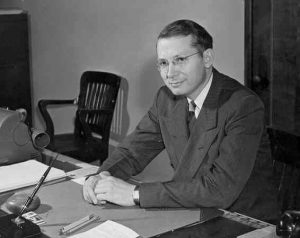
Photo info …
Credit: Indiana University IndianapolisView Source
(Aug. 25, 1907-Nov. 23, 1996). Born in Waterloo, Indiana (DeKalb County), Maynard K. Hine was the son of Clyde Hine MD, a general practitioner. Hine attended the University of Illinois, where he received a DDS degree in 1930 and an MS degree in 1932. After two years in private practice, he studied at the University of Rochester in New York in 1935-1936. He became a faculty member in the Department of Oral Pathology and Periodontics in the School of Dentistry at the University of Illinois in 1936.
In 1944, Hine came to the Indiana University (IU) School of Dentistry as professor and chair of the Department of Oral Pathology and Periodontics. The following year IU president Herman Wells named Hine as the new dean of the school. The school was known for producing skilled practicing dentists but doing little in the way of research. Hine was determined to increase the amount and quality of research done at the school (see ).
The IU School of Dentistry grew significant;y during his tenure and earned a strong reputation in academics and research in such areas as clinical dentistry and materials science. Hine also established the dental hygiene program in 1950 and the Department of Endodontics (concerning diseases and injuries to soft tissues in the mouth) in 1953.
While president of the American Dental Association in 1965-1966, Hine was committed to improving the dental health of children and was a strong advocate for the fluoridation of water. It became a hallmark of his career. One of the most successful and best-known IU School of Dentistry research projects was conducted in collaboration with Proctor and Gamble. The school’s research led to the successful development of fluoridated toothpaste, which Proctor and Gamble marketed under the brand name “Crest.” Hine was fond of saying that the success of the project meant that all he had to do was “ride the crest.”
Hine founded the American Fund for Dental Health and served as its first president. He also served as president of such organizations as the International Association for Dental Research, the American Association of Endodontics, the American Association of Dental Schools, the American Association of Dental Editors, the American Academy of Peridontology, the Fédération Dentaire Internationale, and the American Academy of the History of Dentistry. He was a founder diplomat of the American Board of Endodontics and diplomate of the American Board of Periodontology. He chaired the dental section of the American Association of the Advancement of Science and, at one time, was the organization’s vice president.
In Indiana, Hine was president of the Indiana State Dental Association and the Indianapolis District Dental Society. He chaired the executive board of the Indiana State Board of Health and was president of the Indiana Council on Aging.
In 1968, Indiana University reorganized its units in Indianapolis so that they would report to a chancellor based in Indianapolis rather than to various offices in Bloomington. The name for this new organization was Indiana University Indianapolis (IUI). Herman Wells, serving as interim president of Indiana University, appointed Maynard Hine chancellor of IUI, effective November 1, 1968.
In 1969, Indiana University and Purdue University, reacting to efforts by Indianapolis civic and political to create a new state university in the city unaffiliated with IU and Purdue, agreed to merge their Indianapolis operations. The boards of trustees for both universities approved the merger in January 1969, and Maynard Hine became the first chancellor of (IUPUI).
Hine faced numerous challenges in his new position. He had to bring together faculty from two different academic cultures, create a sense of identity for the new institution, and gain the trust of those who wanted a separate state university. To accomplish these goals, Hine created a structural system that included a council of deans, a faculty council, and a board of advisors composed of prominent Indianapolis residents. Hine also emphasized academic programs that used practical applications of knowledge to solve problems, reflecting IUPUI’s role as an urban university.
Maynard Hine retired in 1973. The Office of Alumni Relations created the Maynard K. Hine Award that year to honor alumni who have made significant contributions to support the IUPUI campus and the alumni program. One of the streets in the Riverwalk Apartments and Townhomes student housing complex and the classroom and conference building on Blake Street is also named for Hine.

Help improve this entry
Contribute information, offer corrections, suggest images.
You can also recommend new entries related to this topic.

